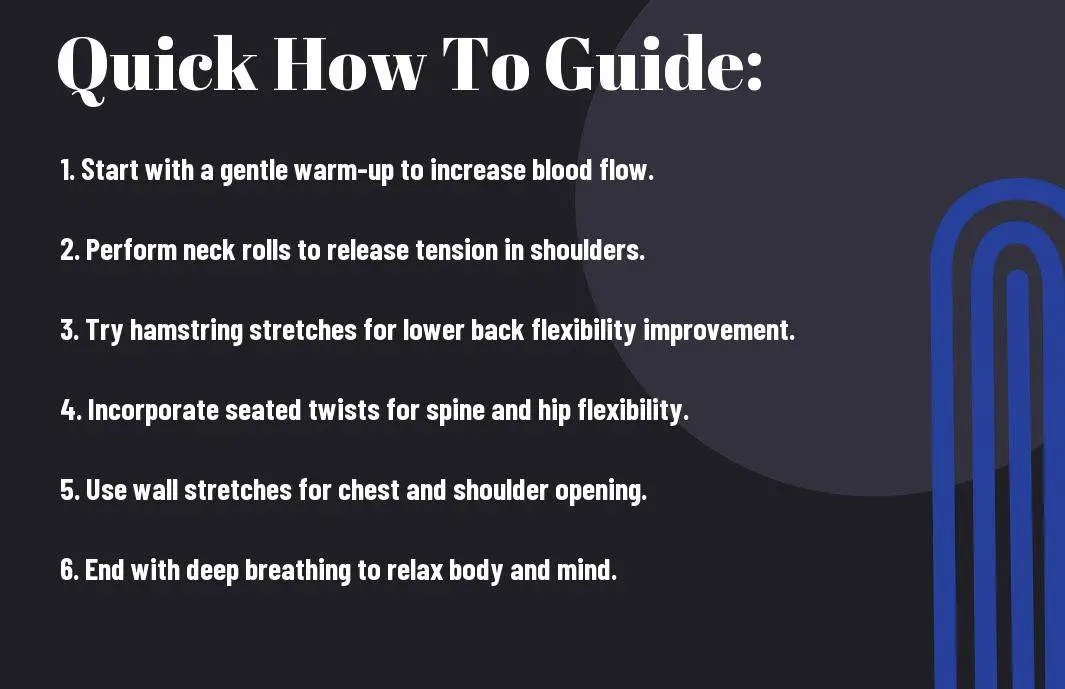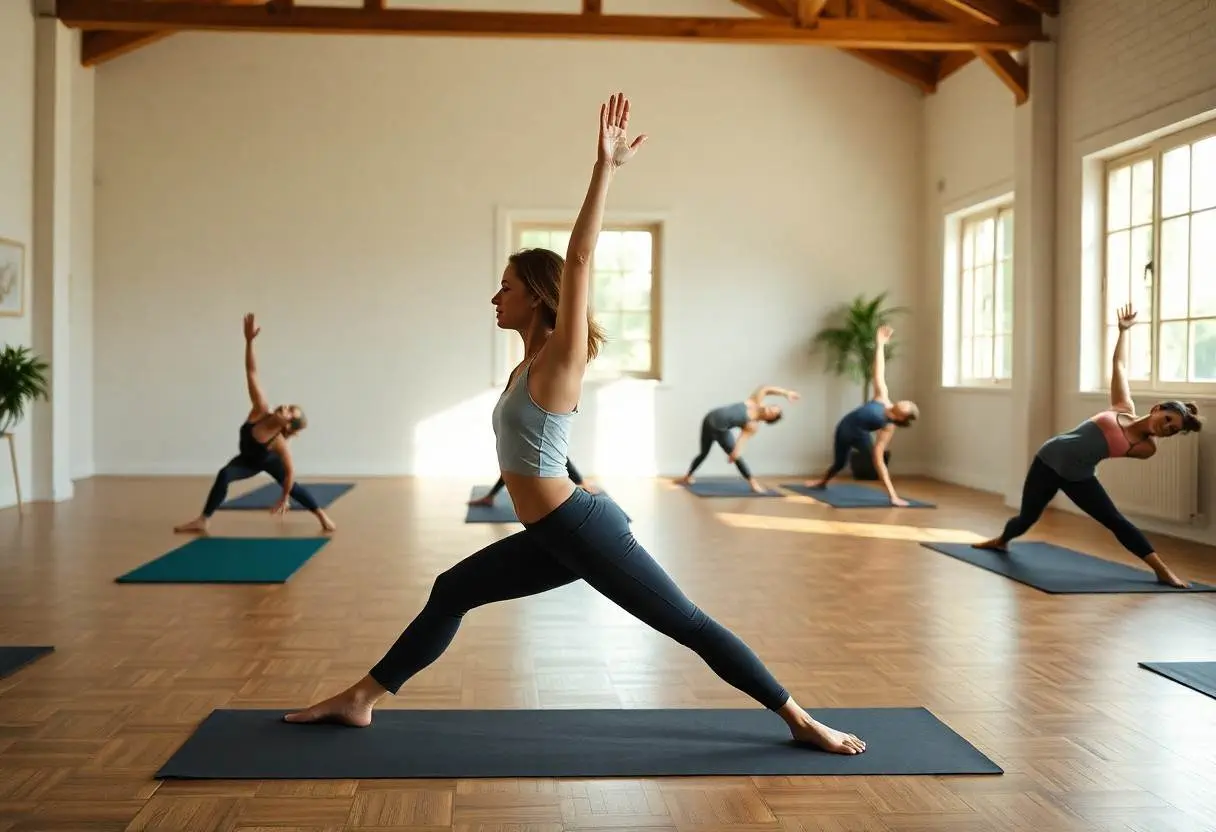Stretches to relieve tension and boost flexibility
Tension relief is closer than you think! Incorporating targeted stretches into your routine can significantly alleviate stress and enhance your flexibility, promoting overall well-being. In this post, you’ll discover a variety of effective stretches specifically designed to loosen tight muscles and improve your range of motion. Whether you’re looking to unwind after a long day or enhance your athletic performance, these simple yet powerful stretches will leave you feeling refreshed and revitalized. Let’s explore how you can seamlessly integrate these stretches into your daily life for optimal relaxation and flexibility.
Understanding Tension
Before you can relieve tension, it’s important to understand what it is and how it impacts your body and mind. Tension often manifests as tightness, discomfort, or pain in your muscles, and it can be a result of both physical strain and emotional stress. When you hold onto tension, it limits your flexibility, which may affect your overall well-being. Recognizing the signs of tension in your body can empower you to take action towards relief and improved flexibility.
How Tension Affects the Body
Any type of tension in your muscles can lead to a cycle of discomfort, reducing your range of motion and increasing fatigue. When your muscles remain tense, they may not function optimally, which can affect your posture and overall physical performance.
Factors Contributing to Muscle Tension
Understanding the factors contributing to muscle tension can aid in prevention and relief. Common factors include:
- Stress and anxiety
- Poor posture
- Repetitive movements
- Lack of physical activity
Knowing these factors allows you to identify areas in your life that may need adjustment to manage tension effectively.
This awareness is key for addressing muscle tension. Additional factors that can contribute include:
- Dehydration
- Inadequate sleep
- Diet lacking necessary nutrients
- Infection or injury
Knowing these elements helps you create a holistic approach to relieve muscle tension and enhance your flexibility.
Importance of Flexibility
While flexibility is often overlooked, it plays a vital role in your overall physical health. Improved flexibility enhances your range of motion, which can lead to better posture and decreased risk of injuries. Incorporating stretching into your routine not only aids in muscle recovery but also helps release tension accumulated from daily activities. When you prioritize flexibility, you’re investing in your body’s longevity and functional capability.
Benefits of Increased Flexibility
The benefits of increased flexibility extend beyond just enhanced movement. Achieving higher levels of flexibility can improve blood circulation, decrease muscle soreness, and increase overall efficiency in your daily activities. You’ll find it easier to perform physical tasks and may even experience reduced tension and stress, contributing to a better mental state.
How Flexibility Enhances Athletic Performance
Now, let’s explore how flexibility can significantly enhance your athletic performance. Increased flexibility allows for better biomechanics, which means your body can move more efficiently during physical activities. This efficiency can lead to improved strength, speed, and endurance. As you adopt flexibility exercises, you’ll notice improvements in your performance, helping you reach and exceed your fitness goals.
It’s important to understand that flexibility not only aids in performance but also reduces the likelihood of injuries. By incorporating stretching routines specific to your sport, you can enhance your explosiveness and agility, enabling you to perform at your best. In addition, flexibility allows for quicker recovery after workouts, ensuring that your body remains in peak condition for training and competition. Prioritizing flexibility can certainly give you the edge you’re looking for in your athletic pursuits.
Essential Stretches for Relief
There’s a wide array of stretches designed to alleviate tension throughout your body. Incorporating these important stretches into your routine can help you feel more relaxed and improve your flexibility. Whether you’re at home or the office, taking the time to stretch can release stress and invigorate your muscles, making it an effective way to boost your overall well-being.
Neck and Shoulder Stretches
There’s no better way to combat tightness in your neck and shoulders than by dedicating a few minutes each day to gentle stretches. These areas often carry the brunt of stress, leading to discomfort and stiffness. Incorporate neck rolls and shoulder shrugs into your routine, allowing for a deeper connection to your body and instant relief.
Upper Back and Chest Stretches
Little adjustments in your daily routine can yield significant benefits for your upper back and chest. Stretching these areas helps counteract the effects of prolonged sitting and hunching over devices. Simple movements like doorway stretches and seated twists can open up your chest and alleviate upper back tension, enhancing your posture and overall comfort.
With consistent practice, you can experience improved mobility and reduced discomfort in your upper back and chest. These stretches encourage better posture, promote deeper breathing, and alleviate tension that accumulates from daily activities. Consider incorporating these stretches during breaks or as part of your morning routine to start your day feeling refreshed and aligned.
Lower Back Stretches
You should prioritize lower back stretches to relieve discomfort and boost flexibility. Gentle movements like the child’s pose or knee-to-chest stretches can significantly ease tension in your lower back, helping to restore mobility and comfort. Integrating these stretches into your day can be a transformative experience.
Plus, adding lower back stretches into your routine can enhance your overall flexibility, making everyday movements easier. These stretches will help reduce tightness and improve your spinal health. If you find yourself sitting for long periods, taking the time to stretch your lower back will help to alleviate discomfort and prevent stiffness, allowing you to feel more at ease throughout the day.
Hip and Leg Stretches
Essential hip and leg stretches play a vital role in improving your flexibility and relieving tension. Incorporating moves like hamstring stretches and hip openers can significantly alleviate tightness in these areas. This practice can promote fluid movement and reduce the risk of injury, especially if you’re frequently on the go.
A few minutes of dedicated hip and leg stretching can lead to a noticeable increase in your range of motion. These stretches help counteract the stiffness that develops from prolonged sitting or physical activity. Integrate them into your routine, and you’ll likely find yourself moving with greater ease and comfort, enhancing your overall physical performance.
How to Incorporate Stretching into Your Routine
For effective results, integrating stretching into your daily routine is important. You can allocate a specific time for stretching – whether in the morning to wake up your body or in the evening to unwind after a long day. Consider designating a few minutes before and after exercising to enhance your performance and recovery. Consistency is key, and combining stretching with other daily activities can make it easier to stick with your routine.
Setting a Consistent Schedule
To reap the benefits of stretching, establish a routine that works for you. Choose specific days and times when you can consistently dedicate time to stretching. Whether it’s a few minutes each morning or a longer session in the evening, create a schedule you can realistically stick to. Building this habit will help enhance your flexibility over time.
Tips for Effective Stretching Techniques
For optimal results, employing the right techniques can make a significant difference in your stretching routine. Focus on holding each stretch for 15-30 seconds and ensure you breathe deeply to alleviate tension. Incorporate static, dynamic, and PNF stretching to cover various muscle groups effectively. Here are some tips to enhance your stretching sessions:
- Warm up your muscles before stretching.
- Never bounce; use controlled movements.
- Listen to your body and avoid pushing through pain.
After integrating these techniques, you’ll likely notice an improvement in your flexibility and reduction in muscle tension.
It’s also important to pay attention to your body during stretching. You should not feel sharp pain; instead, aim for a gentle pull in your muscles. Maintain a relaxed state throughout each stretch, allowing your body to release tension naturally. Seek to create a calming atmosphere to enhance your experience. Consider the following strategies to improve your stretching practice:
- Use props like straps or blocks for assistance.
- Incorporate deep breathing alongside your stretches.
- Group stretching with others for motivation.
After implementing these strategies, you’ll find that stretching becomes a more enjoyable and beneficial part of your routine.
Precautions and Safety Tips
Unlike common assumptions, stretching can lead to injury if not approached correctly. To ensure your safety while stretching, follow these guidelines:
- Warm up with light activity before stretching.
- Avoid bouncing or jerking motions.
- Don’t push your body to the point of pain.
- Consult a healthcare professional if you have pre-existing conditions.
- Stay mindful of your breathing and maintain focus.
Recognizing these precautions can help you enjoy a safer stretching experience.
Listening to Your Body
Clearly, tuning into your body’s signals is vital while stretching. Pay attention to how your muscles feel and adjust your movements accordingly. If you experience pain or discomfort, ease off the stretch and allow your body to relax. Stretching should feel good and promote flexibility; if it doesn’t, reconsider your approach.
Avoiding Common Stretching Mistakes
Any missteps during stretching can hinder your progress and cause injury. It’s important to avoid holding your breath, as this can tighten your muscles. Also, do not overstretch; your range of motion can improve gradually, not instantaneously. Concentrate on maintaining good posture, and don’t rush through your routine.
With consistent practice, you can improve your stretching technique and avoid common mistakes. Focus on proper alignment, as this allows for optimal muscle engagement and reduces the risk of strain. Additionally, ensure you’re doing stretches that are suitable for your fitness level, as attempting advanced stretches without proper foundation can lead to injuries. Consistency in your practice will help enhance your overall flexibility safely.
Maintaining Your Progress
Despite the initial excitement of increased flexibility and reduced tension, maintaining your progress is necessary for long-term benefits. Consistency is key, so integrate stretching into your daily routine. Set achievable goals, revisit your techniques regularly, and stay motivated by celebrating small victories. By committing to a steady practice, you will ensure that your flexibility continues to improve while minimizing discomfort.
Tracking Flexibility Improvements
Maintaining a journal to track your flexibility improvements can be incredibly beneficial. Document your progress by noting the range of motion for specific stretches, how you feel after each session, and any changes you observe over time. By keeping a record, you’ll gain insight into what works best for you and can adjust your routine accordingly for even more effective results.
Adjusting Stretches Based on Needs
Stretches should be tailored to your personal needs and physical capabilities. As you progress, you may find that certain stretches become easier or that you require variations to target specific muscle groups. Listen to your body and make adjustments as necessary to keep challenging yourself while avoiding strain. This adaptability ensures that your stretching routine remains effective and enjoyable.
This flexibility allows you to focus on areas that might require extra attention or to incorporate different techniques that resonate with your body. For example, if you find that your hamstrings are particularly tight, consider adding more specific stretches targeting that muscle group. Alternatively, if a stretch feels too easy, explore deeper variations or try holding the stretch for longer periods. By continually reassessing and adjusting your routine, you reinforce the habit of regular stretching and maximize the benefits for your overall flexibility and well-being.

Summing up
To wrap up, incorporating stretches into your routine can significantly relieve tension and enhance your flexibility. By dedicating just a few minutes each day to targeted stretches, you can improve your range of motion, reduce muscle tightness, and promote overall well-being. Focus on areas that often hold stress, such as your neck, shoulders, and hips. As you commit to this practice, you’ll likely notice increased comfort and vitality in your daily activities, making you more resilient to physical and mental challenges.
